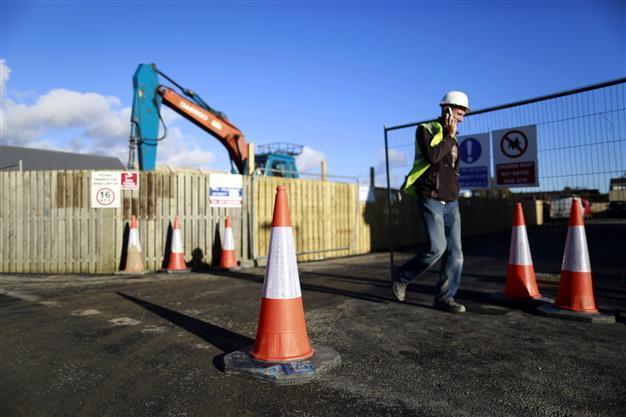After bailout, Ireland goes back to building houses
SWORDS, Ireland - Reuters

A construction worker makes a call on his phone at 'The Cedars' housing development site in the town of Swords situated on the outskirts of Dublin November 4, 2013. REUTERS photo
When 20 newly built family homes went up for sale in this Dublin commuter belt town in September, queues started three hours before the viewing opened on Saturday morning."By Sunday evening there was nothing left," said Brian McKeon, head of MKN Property Group, which built the units on a quiet and leafy dead-end street in Swords, a town of 40,000 near the Irish capital's airport.
The government is counting on places like Swords to resuscitate construction and spur consumer spending on houses and the high street, thereby smoothing Ireland's escape from a 85 billion euro ($117 billion) bailout.
The country of 4.6 million will become the first euro zone state to complete a bailout in December and in the process regain greater flexibility in its economic policy as Europe and the International Monetary Fund loosen their oversight.
Ireland's economy has to expand by an annual 2-3 percent to make its debt sustainable and the government's strategy to achieve this - placing construction at its heart - started to emerge in October with Michael Noonan's 2014 budget.
"No sector has been hit harder since 2008 and a return to a normalised construction and development sector is needed to provide jobs for the thousands of unemployed construction workers," Noonan said in his budget speech.
The finance minister gave tax breaks for the industry that defined the "Celtic Tiger" boom and bust, and raised tax on savings in order to prompt more spending. Noonan is hoping that will spill into shopping and tourism and has forecast personal consumption to jump 1.8 percent in 2014 from an expected 82.5 billion euros this year.
However over the last two years the government has consistently cut its forecasts for personal consumption and economic growth and its dependence on euro zone recovery means the plan is vulnerable to hitches away from home. Meanwhile Irish unemployment is above 13 percent, consumer spending remains depressed by years of salary cuts and tax hikes and economists see consumption growing only 0.7 percent - all further risks to the government's strategy.
GET CONSTRUCTION WORKING
At the peak of Ireland's boom, construction accounted for a quarter of gross national product (GNP). According to state investment agency Forfas, it will be 6.4 percent this year compared with the 12 percent economists say is a healthy size. In Swords, where MKN is building another 18 homes, its cranes and workmen make for an unusual sight - construction accounts for a fifth of total unemployment.
"The quickest way to create jobs is to get construction working again," said Jimmy Healy of the Construction Industry Federation.
Swords provides the perfect construction template: the town combines affordability, transport links and outside space that attracts both young families and first-time buyers. Unlike some swanky Dublin neighbourhoods, where annual prices rises are touching 12 percent, it also has space for new homes.
Nationwide, applications for planning permission have dropped 6 percent so far this year from last and the number of works started have dropped by 10 percent. But applications in Dublin and nearby rose by up to 12 percent, according to Link2Plans, which compiles data from filings.
Ireland's real estate investment trust, Green REIT, jumped in last week and spent 178 million euros on office blocks and retail developments mainly in Dublin.
"It's hotting up and the residential development is coming through," said Link2Plans managing director Danny O'Shea. "Some people have money and it's just a case of getting them to loosen the purse strings and get things moving again."
The anticipated pickup would benefit builders and suppliers such as CRH, Grafton or Kingspan, who have cut exposure to Ireland since the burst housing bubble pushed it to seek a bailout in 2010.
Recovery is expected to be slow, but sustained - far from the uncontrolled boom in the years running up to 2007. Mortgage lending is scarce, hundreds of thousands of people owe more money than their property is worth and nearly 13 percent of existing loans are in arrears for more than 90 days.
Thus the government is looking beyond construction and trying to tempt people to spend more in the shops.
Central Dublin shops and pubs are bustling, Swedish fashion retailer H&M is opening a branch of its COS shops and Tower Records and others are moving to bigger premises. Footfall rose for the first time in 2012 and is up by about 2.5 percent this year, according to Dublin City BID, which represents 2,500 businesses.
But outside of the capital, many smaller towns are still littered with abandoned shops - along with abandoned, remote housing projects that stand as a reminder of unstable times.
"It will be a patchy increase," said Dublin City BID chief executive Richard Guiney. "The rot has stopped but we're not where we need to be." ($1 = 0.7250 euros)
















